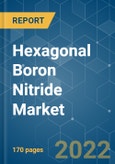The increasing demand for hexagonal boron nitride from high-temperature paints and coatings and increasing demand from the electrical and electronics sector are likely to drive the demand for green building materials. On the flip side, the detrimental impact of the COVID-19 outbreak is expected to hinder the growth of the market.
The coatings/mold release/spray segment dominated the market, and it is expected to grow during the forecast period. These coatings find application in the production of high-temperature, protective release coatings with the functionality of paints.
Increasing demand from the personal care sector, owing to requirements in skincare products, is likely to offer numerous opportunities to manufacturers in the near future.
Asia-Pacific dominated the market across the world, with the largest consumption from countries such as China and Japan.
Key Market Trends
The Electrical Insulation Segment is Expected to Drive the Market Growth
The 2D HBN has been considered as a perfect material for several electronic applications, including 2D hBN-based substrates, gate dielectrics for graphene transistors and interconnects, and electronic packaging insulators. It also appears to be the material of choice for emerging applications, including deep UV (DUV) optoelectronics, electron emitters, and neutron detectors.
The consumer electronics industry has been growing rapidly across the world over the years, owing to the consistently increasing demand for cellular phones, portable computing devices, gaming systems, and other personal electronic devices.
The Indian electronics market is expected to reach USD 400 billion by 2025. India is expected to become the fifth-largest consumer electronics and appliances industry in the world by 2025. In India, technology transitions, such as the rollout of 4G/LTE networks and IoT (Internet of Things), are driving the adoption of electronics products.
In North America, especially in the United States, the electronics industry is expected to grow at a moderate rate. An increase in demand for new technological products is expected to help the market expansion in the future.
The ASEAN region has the fastest-growing consumer electronics segment in Asia-Pacific. Electrical and electronics manufacturing is one of the most prominent sectors in the ASEAN region. The sector accounts for about 30%-35% of the total exports from the region. Most global consumer electronic products, such as radio, computers, and cellular phones, are manufactured and assembled in ASEAN countries.
Hence, with the growth in the electrical and electronics segment, the demand for HBN is expected to rise during the forecast period, and the electrical insulation segment is expected to drive the market growth.
The Asia-Pacific Region is Expected to Dominate the Market
The Asia-Pacific region is expected to dominate the market majorly due to the presence of India and China, which boasts a high consumption volume of HBN due to the growing demand from various applications.
China was one of the largest consumers of personal care products in 2021, and the country is likely to continue its dominance during the forecast period.
The Chinese personal care products market registered a market volume of USD 26,831 million in 2021.
Also, China is the largest consumer of lubricants and greases in the current scenario. The vast manufacturing activities pertaining to different sectors and the rapid growth in the industrial and automotive sectors have pushed the country to stand among the major lubricant consumers and producers in the global landscape.
The Government of India has taken several steps for the promotion of the domestic electronics manufacturing industry and exports from the country. For instance, the Modified Special Incentive Package Scheme (M-SIPS) provides a 20-25% subsidy for investments in capital expenditure for setting up an electronics manufacturing facility. So far, 212 projects have been approved with proposed investments of INR 551.82 billion.
Based on the aforementioned aspects, the region is expected to have the largest market share in the world.
Competitive Landscape
The hexagonal boron nitride market is consolidated, with the top 10 players accounting for nearly 60% of the overall demand. Saint-Gobain is the leading producer in the market, with a wide range of boron nitride product offerings for different applications. Other key players include 3M, Höganäs AB, Showa Denko K.K., and Denka Company Limited, among others.
Additional Benefits:
- The market estimate (ME) sheet in Excel format
- 3 months of analyst support
This product will be delivered within 2 business days.
Table of Contents
Companies Mentioned (Partial List)
A selection of companies mentioned in this report includes, but is not limited to:
- 3M
- American Elements
- Denka Company Limited
- Henze Boron Nitride Products AG
- Höganäs AB
- Kennametal Inc.
- Mizushima Ferroalloy Co. Ltd
- UK Abrasives
- Saint-Gobain
- SHOWA DENKO K.K.
- GrollTex Inc
- Momentive
- ZIBO SINYO NITRIDE MATERIALS CO. LTD
- ZYP Coatings Inc.








